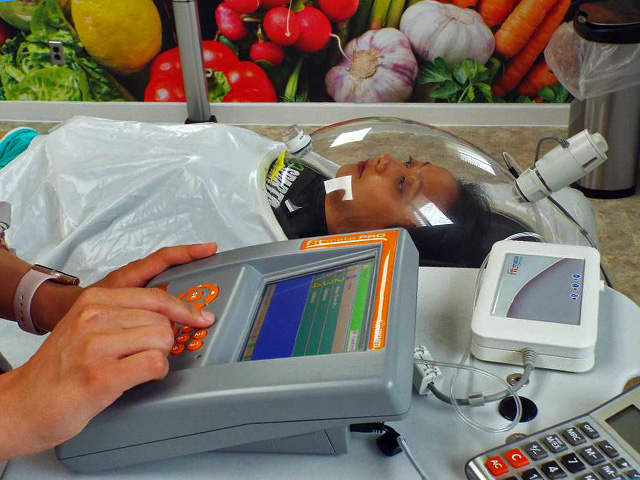Resting Metabolic Rate (RMR) and Basal Metabolic Rate (BMR) are measures of resting energy expenditure, which can be helpful in assisting patients with weight loss. BMR and RMR represent the minimum amount of energy required to keep your body functioning, including your heart beating, lungs breathing, and maintaining normal body temperature. Although the terms BMR and RMR are sometimes used interchangeably, they are measured under different conditions and have slightly different interpretations.
Described below is the method for directly measuring resting metabolic rate. A less common method is to use direct calorimetry which measures the heat generated by the body in an enclosed space. See also some simple equations for estimating BMR and RMR.
aim: to directly determine resting oxygen consumption as a measure of metabolic rate at rest.
equipment required: O2 and CO2 gas analyzers, ventilation measurement by a pnuemotach or turbine ventilometer (as used for VO2 measurement).
 using a Cosmed K5 to measuring resting energy consumption
using a Cosmed K5 to measuring resting energy consumption procedure: The difference between BMR and RMR is in the subject preparation. BMR measurements are typically taken in a darkened room upon waking after 8 hours of sleep with 12 hours of fasting to ensure that the digestive system is inactive, and with the subject resting in a reclining position. On the other hand RMR measurements are typically taken under less restricted conditions than BMR. For BMR you should avoid any exercise or stressful situations for at least two hours prior to the test, as well as eating a meal or ingesting caffeine or other stimulants in the previous 4 hours. Smoking should also be avoided during that time. During the test the subject should be seated or reclining comfortably in a quiet room set at a neutral temperature, and not speaking, reading or watching television so that they can fully relax. Rest the subject for at least 10 minutes in these conditions before starting the measurements.
measurement: The apparatus measures the oxygen consumption of the body (VO2) and the carbon dioxide (CO2) produced. Measurements should be taken for at least 10-20 minutes or until the values have stabilized. The results can show if you have increased or decreased metabolism, and the respiratory exchange ratio can show whether your body primarily uses fats or carbohydrates for energy.
disadvantages: this test requires expensive equipment and is labor intensive. There are alternative equations for calculating BMR and RMR.
comments: metabolic rate measurements can change over time, and are affected by body weight, height and age.
Related Pages
- All about Basal Metabolic Rate
- Equations for calculating BMR and RMR
- Power output and energy expenditure for running and walking
- Measuring Oxygen Consumption by Indirect Calorimetry
- About Energy Expenditure — methods, formula and calculators.
- All about the respiratory exchange ratio
- Calories Burned Running — determines how many calories you have burned based on your weight and distance run.
- Daily Calorie Counter — determines how many calories you need each day
- More Health Tests
- Calculating Daily Energy Expenditure — a few formulas to estimate your daily energy expenditure.
- Lose weight while doing nothing — Not really nothing, but indirectly by changing your metabolism through exercise.
- Health Tests for Athletes


 Current Events
Current Events